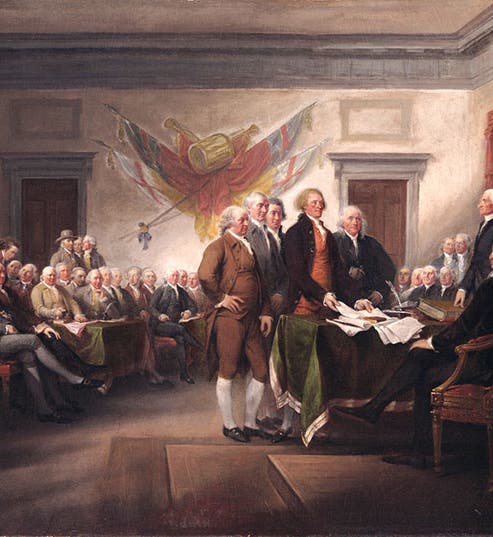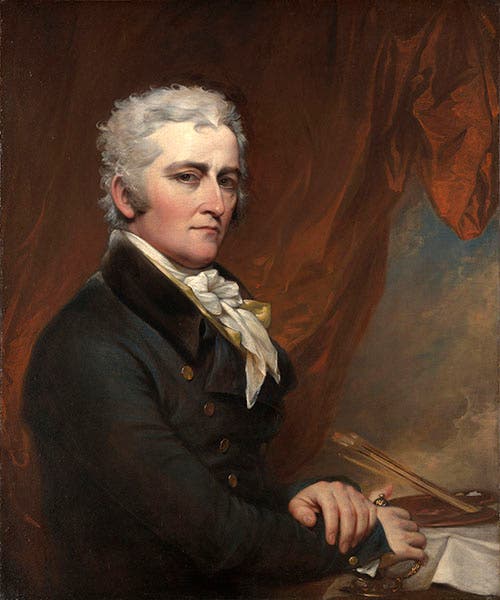Scientist of the Day - John Trumbull and Benjamin Silliman
John Trumbull, an American painter, was born June 6, 1756. John was the son of Jonathan Trumbull, Sr., who was governor of Connecticut during the Revolutionary War, and the younger brother of Jonathan Jr., who would govern Connecticut during the early decades of the Republic. But John was an artist, and he devoted much of his life to capturing on canvas the major events of and participants in the War of Independence. Some of his paintings were monumental, destined for installation in the rotunda of the US. Capitol. But most were smaller, and these he kept for himself, hanging them in his home in New York City. They included the small versions of the Battle of Bunker Hill, the Signing of the Declaration (first image), and portraits of George Washington and Alexander Hamilton, along with dozen of miniatures.
Enter Benjamin Silliman, a chemist who taught geology and natural history at Yale, edited the first important U.S. scientific journal, the American Journal of Science and Arts, and in 1809 married Harriet Trumbull, the daughter of Jonathan Jr., and therefore John Trumbull’s niece.
One day in 1830, Silliman was visiting his wife’s uncle in New York City. Trumbull had been paid handsomely for his four large rotunda paintings in 1825. But now he had no source of income. Trumbull indicated that he would be happy to give his collection to Yale, if they would just give him an annual allowance that he could live on until he died. Silliman went back to Yale and immediately corralled the President, and they started to work on an agreement that would be mutually agreeable to all. Silliman, who had trained in law before converting to science, himself worked out most of the details, including finding donors to fund the annuity. Yale agreed to pay Trumbull $1000 a year for life and promised to build a gallery for the paintings, a building that they allowed Trumbull to design. This was the first charitable gift annuity in the United States and a milestone in gift planning, and the Trumbull Gallery was the first college art museum in the country. By the time Trumbull died in 1843, the building had been completed, and it was soon filled with Trumbull’s paintings, more than 100 works of art, the largest Trumbull collection in the world. And as per the agreement, they are all still there (although the original building was razed in 1905 and later replaced with the Yale University Art Gallery).
So if you want to see the Signing of the Declaration, or the Surrender of Cornwallis at Yorktown, head for New Haven, Connecticut. While you are there, you can see John Trumbull’s self-portrait (second image), although it was a later gift and not part of the original bequest. But if you want to see Trumbull’s portrait of Silliman, you need to visit the National Portrait Gallery in Washington, D.C. That one escaped.
You almost certainly know that a portrait of Hamilton is on the U.S. ten-dollar bill; it is taken from a Trumbull portrait, but not the one at Yale, but rather one at New York City Hall . You might need to be reminded that the Signing of the Declaration is on the reverse of the two-dollar bill.
And if you would like to see the large version of the Signing of the Declaration, you may either visit the U.S. Capitol, or click here.
Dr. William B. Ashworth, Jr., Consultant for the History of Science, Linda Hall Library and Associate Professor emeritus, Department of History, University of Missouri-Kansas City. Comments or corrections are welcome; please direct to ashworthw@umkc.edu.




![“Aurora Borealis,” hand-colored wood engraving by Josiah Wood Whymper, [Natural Phenomena], plate 2, 1846 (Linda Hall Library)](https://assets-us-01.kc-usercontent.com:443/9dd25524-761a-000d-d79f-86a5086d4774/0245ffcb-b70c-477c-8792-0a73ebd54eb2/Whymper%2011.jpg?w=210&h=210&auto=format&fit=crop)


